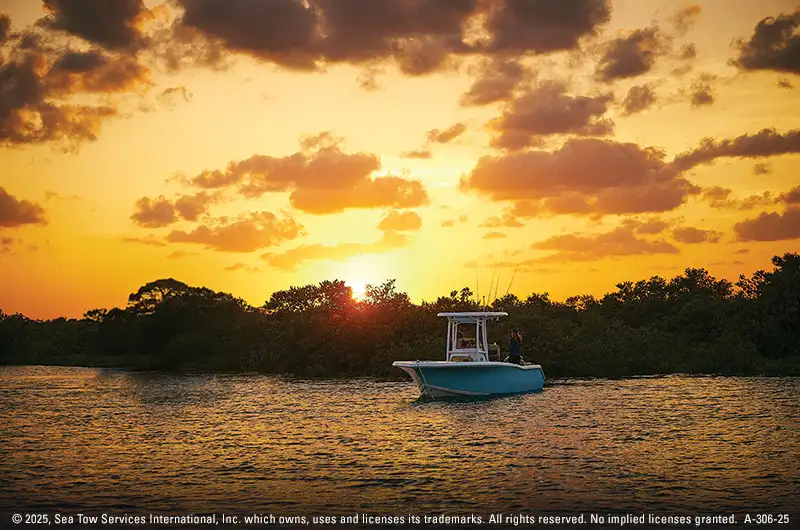
Essential Tips for Boating After Dark
It’s important to be smart, attentive and ever-watchful anytime you step up to the helm, but in regards to cruising after dark, you need to further up your game. Whether taking a ride to check out The Milky Way, view fireworks, fish the graveyard shift, or simply returning from your favorite dock & dine, operating a boat in the dark requires an extra dose of concentration.
True, you probably have plenty of lighting, a good electronics package and enough local knowledge to ensure a safe passage.
So, what could possibly go wrong?
The answer is “plenty” if you don’t take the task seriously enough.
Miscalculation, poor judgement and bad luck compounded by restricted vision have a habit of leading to uncomfortable, dicey and even dangerous situations once the sun goes down. Indeed, boaters are more likely to miss-identify their destination or even home ports once the sun drops below the horizon. Others might fail to see another vessel, leading to collision. Some have struck jetties or docks at full speed, and even the most seasoned skippers and their crews are more likely to run aground under the cover of darkness.
Dislodged dock pilings, floating logs, low-profile sandbars and the like are harder to spot, and are a recipe for damage to your boat and possible injuries to you and your crew. Even gauging the height and force of waves becomes more complex in a nighttime scenario. That can lend itself to some surprising bumps in the dark if you fail to notice a rogue roller, large boat wake, strong rip, or confluence of currents.
As with most things on the water that old scout saying, “Be prepared,” serves well especially on the darkest of nights. If you expect to be cruising after sunset, prepare in advance before leaving the dock or launch ramp.
Tips for Boating in the Dark
Consult Navigation Charts
Start with a look at your navigation charts to ensure your route and way points are accurate and clearly defined.
Double-check that all navigation lights are functioning properly, and that you have working red-filtered flashlights on board (the filters reduce the flashlight glare). If you use them, ensure headlamp batteries are fully charged, too. Prior to departure you’ll also want to clear the deck of the day’s debris, toys or fishing gear. Naturally, ensure you have the required number of properly-fitted jackets aboard.
Dim Lights that Cause Glare or Visibility Issues
Before getting underway be sure to dim or eliminate onboard lights that compete with your vision.
Dim cabin lights, accessory deck-lighting and electronics displays so you’ll have the clearest vision possible when peering out from the helm in any direction.
Stay on the Alert
Making way, stay alert and appoint a lookout.
Carefully follow the guidance provided by navigation devices, and keep your ears open for whistles, horns, gongs, voices and other boats. Realize, too, that seeing both red and green lights approaching is a boat headed straight in your direction. Take evasive action early to alleviate such threats. As with any other boating situation, a word on your VHF radio can help clear things up.
Manage Your Speed
Lastly, pull back on the throttle when cruising after dark.
Caution should be your safe word at all times because it’s never worth risking family, friends, crew or your vessel to tie up a few minutes sooner.
In short, prepare ahead, slow down and stay well within the rules to ensure you get home safely.
FAQs
Is it hard to boat at night?
Yes, boating at night is more challenging than daytime boating for several reasons:
- Reduced visibility: It’s hard to see obstacles, other boats, or the shoreline clearly.
- Harder navigation: Landmarks and buoys are difficult to identify in low light.
- Increased collision risk: It’s easier to miss other vessels, floating debris, or submerged objects.
- Nighttime disorientation: It’s easier to lose your sense of direction on open water, especially without good GPS/chartplotters.
- Fatigue: Your reflexes and focus are likely diminished after a long day.
That said, it’s manageable and safe with preparation and proper lighting. Many experienced boaters enjoy night cruising for fishing or stargazing, but it requires caution, slower speeds, and a good understanding of navigational lights and local waters.
How do you see while boating at night?
You use a combination of tools and techniques:
Lights
- Navigation lights (required by law): Red (port), green (starboard), and white (stern or anchor) so others can identify your boat’s direction.
- Spotlight or handheld searchlight: Useful for momentary checks on buoys, docks, or obstacles.
- Deck/cabin lights (dimmed): Red or amber lighting preserves night vision without blinding the operator.
Instruments
- Chartplotter or GPS: Essential for tracking your position and route when landmarks are invisible.
- Radar (if equipped): Detects other boats or landmasses in poor visibility.
- Depth finder/sonar: Prevents grounding in unfamiliar or shallow waters.
Human techniques
- Preserve night vision: Avoid bright white lights and let your eyes adjust for 15–30 minutes.
- Go slow and stay alert: Reduced speed gives you time to react.
- Use moonlight and shoreline lights: On clear nights, natural light can be surprisingly helpful.
So while you can’t “see” the same way as in the day, with the right tools and habits, night boating becomes safe and navigable.
